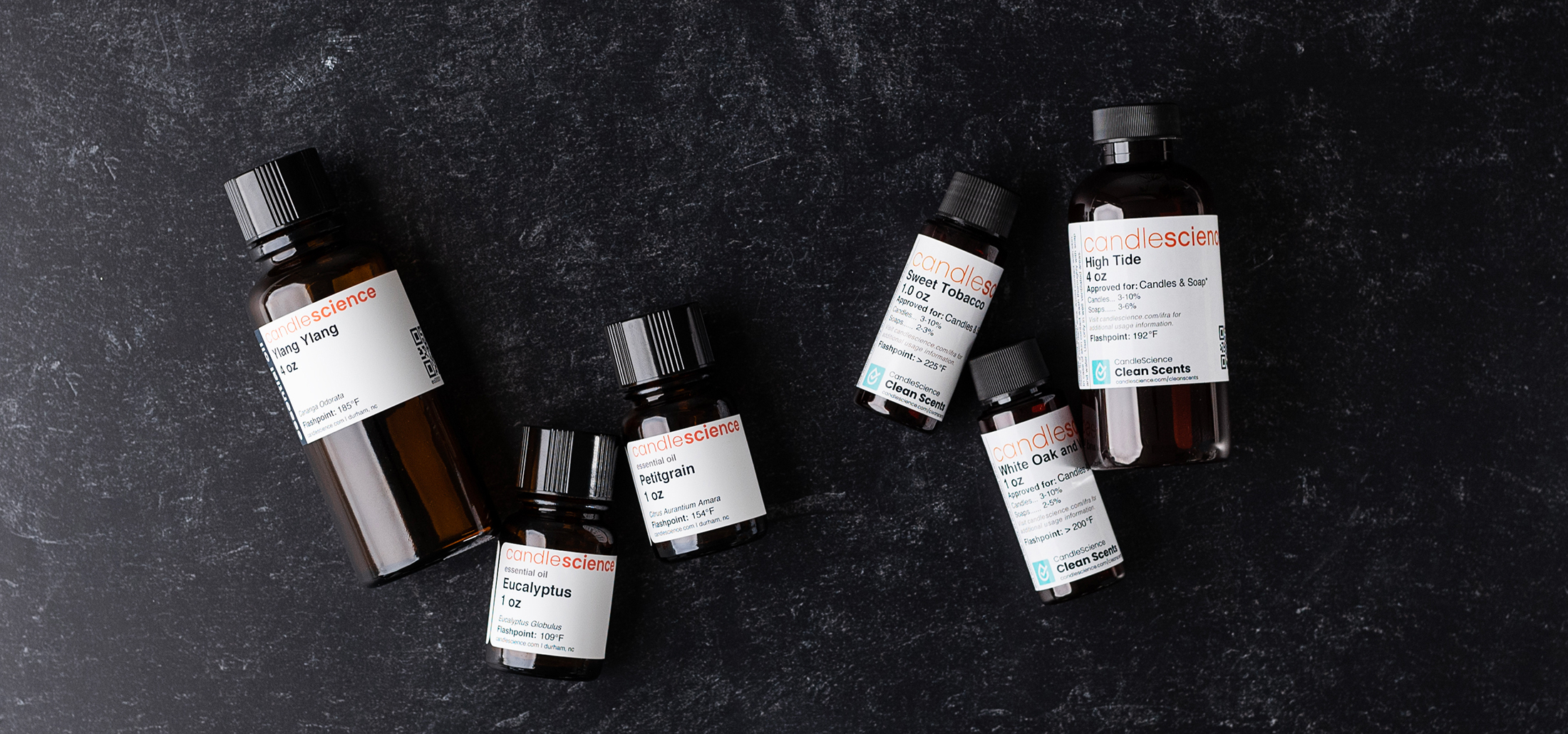The difference between essential oils and fragrance oils

Essential oils are...
Essential oils (EOs) are a substance extracted from the seeds, flowers, leaves, roots, stems, or bark of plants, typically through steam distillation, expression, or extraction. You’ll often spot them in perfumes, soaps, cosmetics, household cleaners, incense, and other similar products. Because they contain the fragrance of the plant from which they are derived, essential oils are used in a variety of scent-related applications like perfumes, flavorings, cosmetics, household cleaners, and medicines.
And yes, you’ll also spot them used to scent candles. The performance of essential oils in candles is variable. EOs are not created for the primary purpose of scenting candles–candles are merely one possible application out of dozens of others.
Fragrance oils are...
Fragrance oils (FOs) are a combination of essential oils and synthetic aroma chemicals. Like EOs, FOs are used in a variety of different applications to scent consumer products.
Unlike EOs, however, FOs sold by candle suppliers are formulated with specific purposes in mind, like candle making. These FOs are intended to be burned, and so are generally better than EOs at retaining the integrity and strength of the aroma while it is burning in a candle.
Fragrance oils make it possible to create candles and other products with aromas you could not achieve with essential oils. Think scents like fresh baked cookies or a crackling fire–things that a plant-derived material simply cannot replicate.
When should I use EO, and when should I use FO?
You might now be wondering: should I use fragrance oil or essential oil for my products?
Fragrance oils are a wonderful choice for candles, and are what we tend to recommend for most folks. Let’s look at some of the benefits of fragrance oils:
-
Performance.
Fragrance oils are intended to be burned in a candle and are created with this purpose in mind. In general, fragrance oils throw fragrance more strongly and retain the characteristics of the aroma while burning. -
Cost.
Fragrance oils are generally inexpensive compared to essential oils, especially when purchased in bulk quantities. This is a big plus for those who use higher fragrance loads in their candles. -
Variety.
Fragrance oils are available for nearly every aroma you can possibly imagine–and many that you can’t! Essential oils cannot replicate scents like cheesecake or salty sea air, but fragrance oils can. -
Ease of use.
Fragrance oils are friendly for beginners and give great results when used as recommended.
As we mentioned further up, essential oils aren’t created for the sole purpose of candle making. Historically, we even encouraged avoiding EOs in candles. Now that we have a line of essential oils we have personally (and extensively) tested, we’re confident in recommending their use. (Note that not all our essential oils perform well in candles–make sure to look at the Candle Maker’s Notes for any EO you’re interested in.)
Now, let’s look at some reasons you might consider using CandleScience essential oils in your products:
-
They’re a natural product.
EOs are derived from plants and quality essential oils do not contain any synthetic components. This might be important to you personally, or for brands centered around natural ingredients and environmental awareness. -
Cost.
Yep, this is both a pro and a con depending on your brand! Essential oils can be significantly more costly than fragrance oils. For those with luxury brands and price points on the higher side, using 100% EOs in your products is a great way to justify that price point. -
They're tested for performance.
CandleScience essential oils are extensively tested for performance in a variety of bases. We can’t speak to other essential oils, but the oils that we offer have detailed Candle Maker’s Notes and Cold Process Performance notes to help you sort out what products you can make with our essential oils, how to make them, and what type of performance you can expect.
How do I safely handle and store EOs? Is it different from handling/storing FOs?
When working with both fragrance oils and essential oils, keep these things in mind:
- Work in a well-ventilated area with plenty of fresh air flowing. Keep a window open, or run the exhaust fan over your stove if working in the kitchen.
- Use protective equipment like eye goggles and gloves.
- Containers or jars used to weigh or hold essential oil or fragrance oil should not be reused for food prep.
- Clean up spills immediately, as they may cause damage to surfaces.
Fragrance oils:
Should be stored in climate controlled spaces and kept away from exposure to light, extreme temperatures, and moisture. Best practice is to use them within a year of their purchase.
Essential oils:
Should be stored in an airtight container and kept refrigerated separate from food and out of reach from children and pets. As naturally derived products, they are more sensitive to their environment than fragrance oils. This storage method helps to slow oxidation and provides the longest shelf life possible. Oxidation is a natural process that occurs as atmospheric oxygen combines with essential oil constituents; this can cause the scent and viscosity of the essential oil to change. In the case of essential oils, it makes them spoil more quickly. Oxidized essential oils are not recommended for use due to the risk of adverse skin reactions. With proper storage conditions, oxidation is a slow process and is typically a non-issue for essential oils, as long as they are used within 6-12 months.
When you’re working with essential oils, it’s important to remember that they are super concentrated. Direct contact with pure, undiluted (ie, not mixed in wax, soap, lotion, etc) EOs may cause reactions. Take the precautions like gloves and eye goggles we mention above, and if you have specific concerns speak with your doctor.